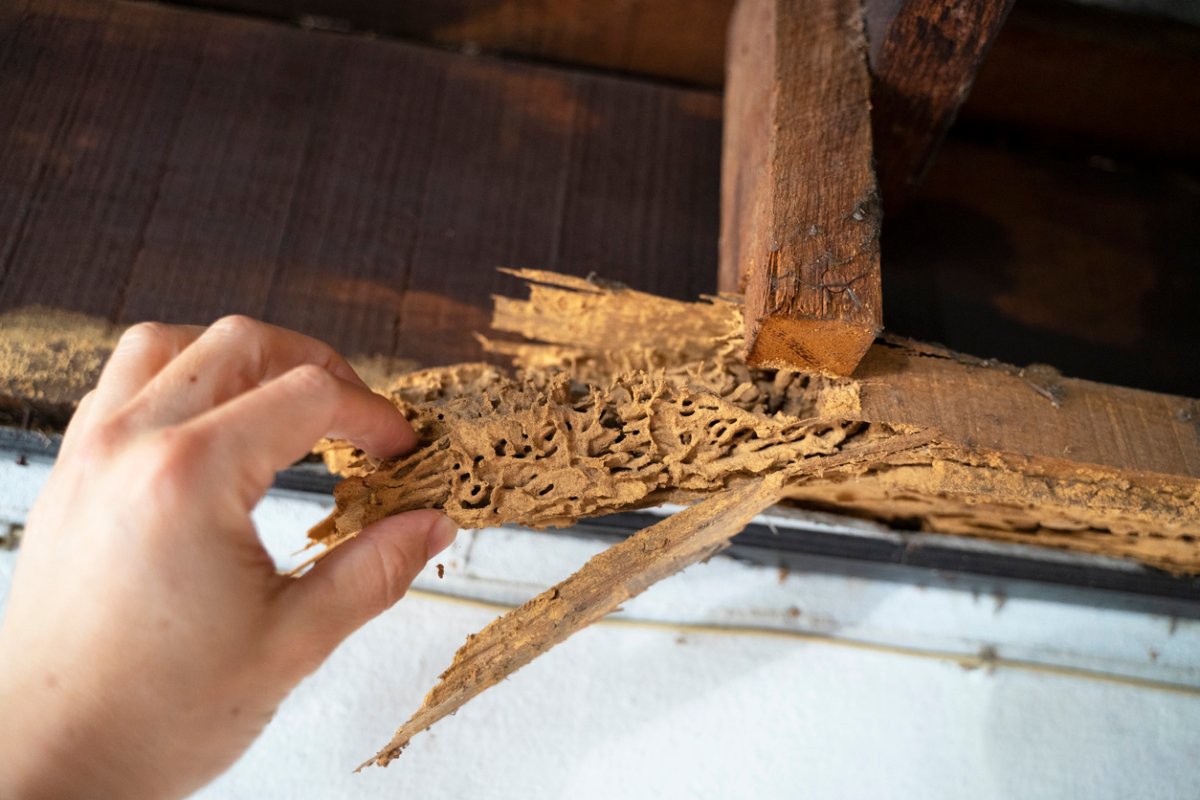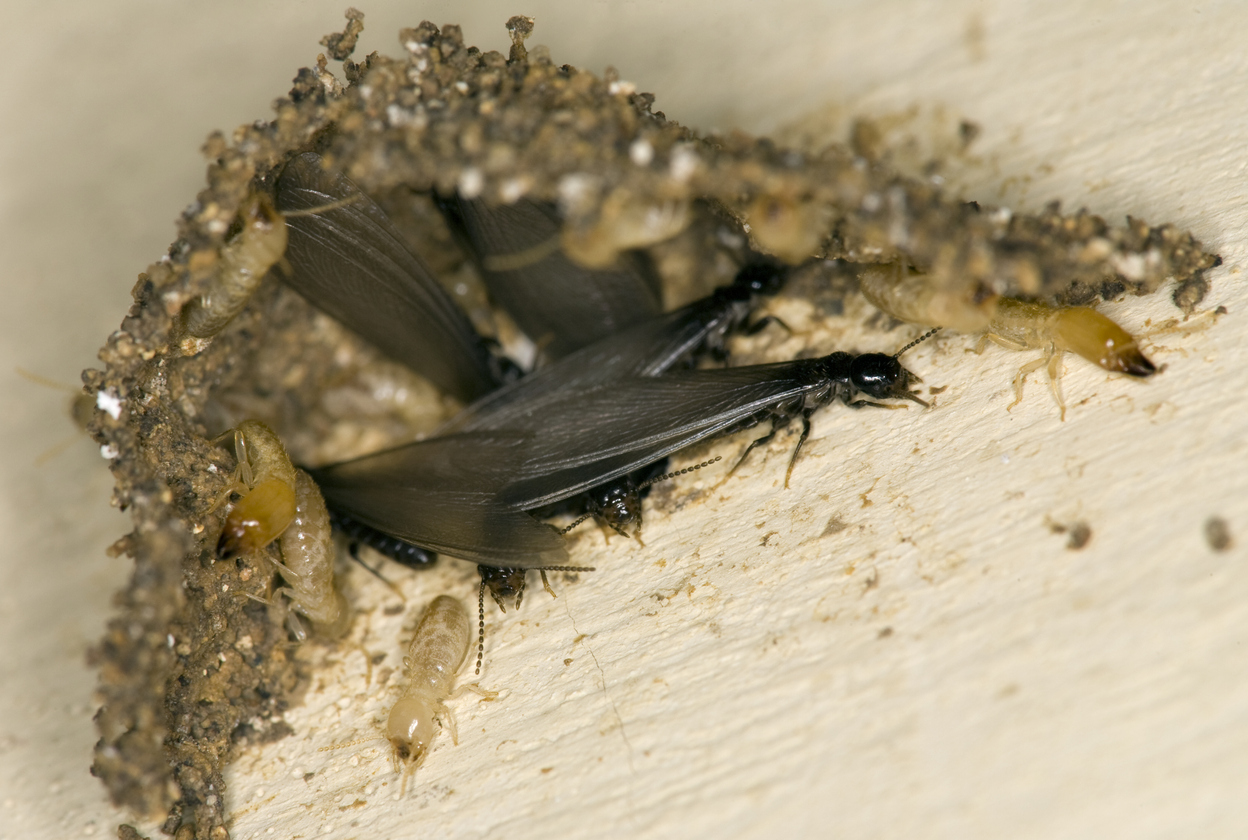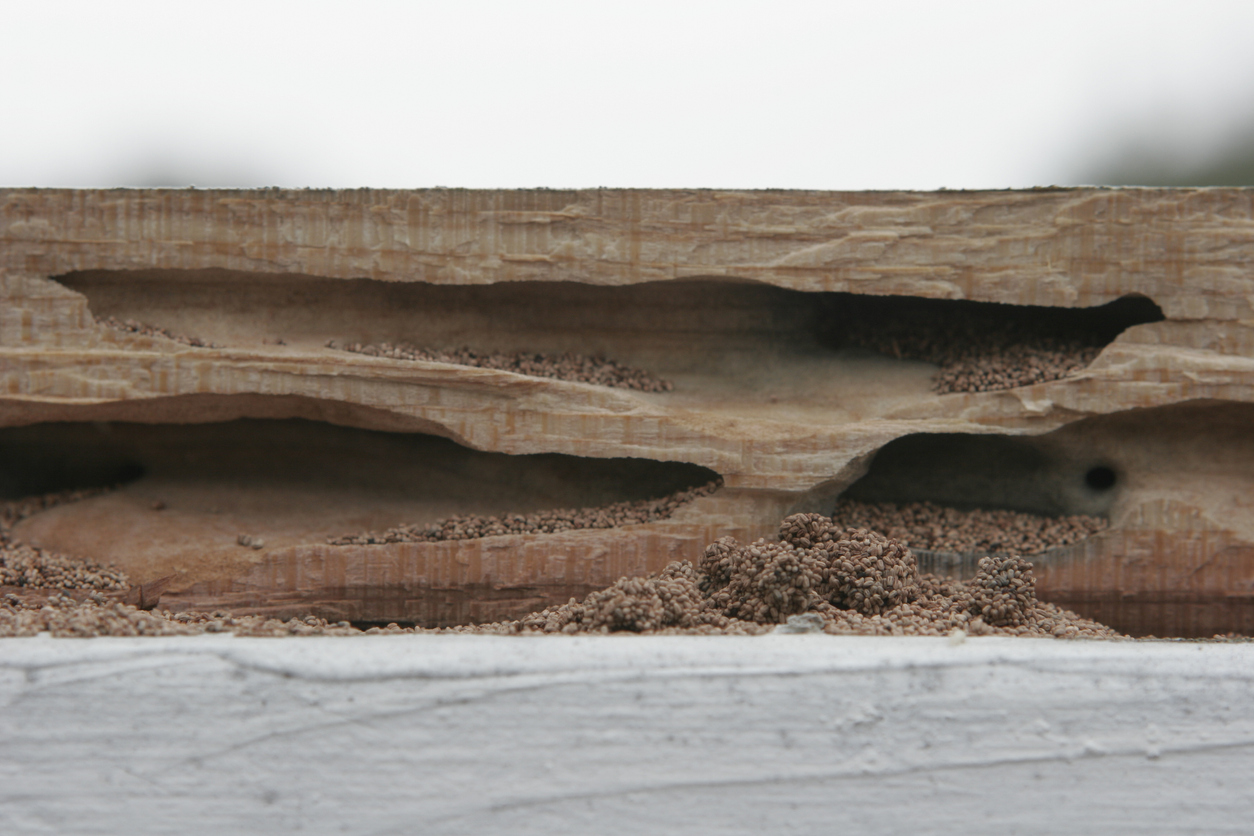

We may earn revenue from the products available on this page and participate in affiliate programs. Learn More ›
When it comes to termite vs. carpenter ant damage, it may be difficult for many people to discern one from the other. By taking a closer look at the damage and at the insects themselves, a homeowner will be able to tell if they have a problem with termites or carpenter ants. While both of these are destructive pests, they are both wood-destroying insects and can cause significant damage to the wooden structure of a home.
Termites and carpenter ants share some similarities, such as swarming during the spring months to mate and their ability to burrow into wood. The difference between carpenter ants and termites can be seen in their physical appearance: body and antenna shape, wing type, and color.
- Body shape. Carpenter ants have a clearly defined pinched waist, while termites maintain the same width throughout the length of their body with a more rectangular body shape. A carpenter ant body is divided into three body segments—head, thorax, and abdomen—while a termite has two body segments, which are made up of a head and a thorax.
- Antennae shape. A carpenter ant antenna is bent or elbow-shaped with two large segments. Termite antennae resemble a string of beads, whereas a termite has straight antennae.
- Wing type. Both types of damaging insects have two sets of wings, which can be useful for quickly identifying them. A carpenter ant has wings that are well proportioned to its body, and the hind wings are shorter than the front wings. Termite wings are of equal length and are much longer than the insect’s body. These fragile wings fall off easily and can commonly be seen at the entrance of a termite nest. The color of termite wings can range from dark brown to gray.
- Color. Worker ants typically have dark-brown bodies, but they can also be black, reddish, or even yellow in color. Termite workers can be creamy white or transparent in color and depending on the type of termite, they can also range from dark brown to black.
1. Homeowners are likely to notice winged termites or ants before spotting their damage.
The reproductive members of a termite or carpenter ant colony have wings and are called swarmers. The winged carpenter ants can typically be seen leaving their nest at night in search of food sources that can include pet food, fruit, meat, and sweets. Termites are usually much harder to spot since they typically keep to their tunnels and stay out of sight. Swarmer termites will leave their colony when they’re looking for a mate. Swarming season for carpenter ants and common types of termites is in the spring, but it can also happen during the summer and fall for dampwood and drywood termites. If a homeowner notices winged pests or discarded wings inside or near the home, that’s a sign of carpenter ant nests or a termite colony.

2. Carpenter ants leave behind smooth tunnels, whereas termites can create rough ones caked with mud.
Depending on the type of infestation, carpenter ants and termites create different types of wood damage. Damaged wood that’s caused by carpenter ants looks smooth, clean, and almost polished. Carpenter ants don’t actually eat the wood, but they tunnel through the material to make a cozy home. On the other hand, termites eat the wood and will absorb nutrition from the wood particles with the help of microscopic protozoa that live in their stomachs. The continuous, round-the-clock eating of the termites can be extremely destructive to a wooden structure. Termite damage is rough-looking with soil and mud tubes that contain dead insects, pellets, and wood debris.
3. Subterranean termites will create mud tubes on a home’s exterior, while carpenter ants will not.
Subterranean termites eat wood and damage the wood structure. Since these insects have thin skin and will dry out quickly when they’re exposed to sunlight, they build shelter tubes for protection. These tubes are made from moist soil and are typically built between soil and wood or on the outside of walls. The tubes are covered pathways for the termites so they can travel undetected on their way to eat as much wood as possible. While carpenter ants are attracted to food debris, termites eat cellulose, which they find primarily in wood, but they will also eat paper, boxes, wallpaper, drywall, carpet, and insulation if there’s no wood to be had. If a homeowner sees mud tubes on the outside of the home, it’s recommended to call a pest control expert to deal with the termites.
4. Termite frass (droppings) looks different than the sawdust carpenter ants create.
Termites create frass, or a mixture of insect waste, saliva, chewed-up wood, and insect parts. Frass is usually the same color as the surrounding wood, but it can look different depending on the type of termite that has invaded the space. Termite frass can be found indoors or outdoors. Drywood termites leave behind droppings that resemble small grains of salt and pepper. When they’re inspected under a magnifying glass or zoomed in on a camera, it’s possible to see that termite droppings are typically oval in shape and have six sides. An infestation of carpenter ants leaves behind what looks like tiny piles of sawdust by the small kick-out holes they tunnel into the wood. This sawdust is made up of soil, insect parts, and wood fragments.

5. Carpenter ants prefer moist wood, while different types of termites prefer moist or dry wood.
Carpenter ants usually make their nests in moist wood in areas that surround sinks, bathtubs, leaky chimneys and roofs, and exterior entry points into a home. Attic vents, cracks in the foundation, and pipe entries make good areas where carpenter ants can find their way into a home and make a nest. Damp and decaying wood is the food of choice for subterranean and dampwood termites, although drywood termites, as their name suggests, prefer dry wood.
6. Carpenter ants typically aren’t as destructive as termites, but they can still cause thousands of dollars in damage.
Carpenter ants are not as destructive as termites, but they will still damage the wooden structure of a home. Since carpenter ants don’t eat the wood they live in and they create tunnels in the material to make their nests, their damage isn’t as obvious as the havoc termites leave behind with their nonstop eating. If a homeowner notices carpenter ants in or around the home, it’s best to take pest control measures as quickly as possible.
7. Pest control professionals can treat termite and carpenter ant infestations.
Calling one of the best pest control companies such as Terminix or Orkin can help mitigate any issues with a termite or carpenter ant infestation. It’s recommended to get the advice of a professional when it comes to getting rid of destructive pests that are eating away at or tunneling through the home. Termite infestations require a professional bait system or a chemical spray, while carpenter ant problems can most times be controlled by eliminating the food source that attracted them to the area. Keeping the house free of carpenter ants and termites involves eliminating items that attract them so they will stay away from the home.
